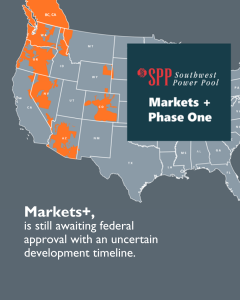BPA Threatens to Split the Western Electric System
Energy markets are formal structures through which electric utilities can buy and sell energy. In a “day-ahead” market structure, participants buy and sell electricity at a set price for the following day. In general, markets with more participants and a wider footprint create greater benefits and efficiencies, which are shared among the participants. In the West, two day-ahead energy markets are currently competing to attract utilities to join their footprint. The Bonneville Power Administration (BPA), which sells power from federal dams on the Columbia and Snake Rivers, is currently deciding which of the two markets to join.  The Extended Day-Ahead Market (EDAM) is the larger and more well-developed of the two. Built on the successful Western Energy Imbalance Market, which most Western utilities have already joined, several major utility players have already signaled their intent to join EDAM, including PacifiCorp, Portland General Electric, Idaho Power and NV Energy. EDAM’s structure has been largely approved by federal regulators and is expected to go live in 2026. Markets+, developed by the Southwest Power Pool, is the competing market, though its backers only recently submitted documents to federal regulators for approval. The timeline for this market’s development is uncertain. For more information, read more from the Northwest Energy Coalition here.
The Extended Day-Ahead Market (EDAM) is the larger and more well-developed of the two. Built on the successful Western Energy Imbalance Market, which most Western utilities have already joined, several major utility players have already signaled their intent to join EDAM, including PacifiCorp, Portland General Electric, Idaho Power and NV Energy. EDAM’s structure has been largely approved by federal regulators and is expected to go live in 2026. Markets+, developed by the Southwest Power Pool, is the competing market, though its backers only recently submitted documents to federal regulators for approval. The timeline for this market’s development is uncertain. For more information, read more from the Northwest Energy Coalition here.
The Problem
In April 2024, BPA staff indicated that they were “leaning” toward joining Markets+ and laid out a schedule through which the agency would issue a decision on which market to join by November 2024. Both this process and BPA’s leaning to join Markets+ are problematic for several reasons: 
- Joining EDAM is a better path to offsetting Northwest hydroelectric production and saving salmon. The broad base of clean resources available through EDAM could allow BPA to generate less power from the federal hydrosystem and reduce harm to endangered migrating salmon and steelhead. EDAM is also more likely to encourage development of new carbon-free resources and transmission.
- There’s no reason to decide on joining any market right now. Both markets are still shaping into form, and Market+ hasn’t yet received federal approval. EDAM is undergoing changes to its governance to better support participation from entities outside the state of California. BPA has not laid out any reason why it is making this decision in 2024, or why a delay isn’t warranted.
- BPA joining Markets+ will split the region and dilute the benefits. Western utilities and BPA should unify into a single market, not a bifurcated system. A single Westwide power market will allow broader use and development of lower cost, carbon-free power sources that will aid in decarbonizing the energy system and lowering electricity costs for consumers.
The Solution
To maximize the efficiency of the system and bring maximum benefits for salmon, steelhead, and decarbonization, BPA should change course and join the Extended Day-Ahead Market. First, though—they need to slow down. BPA should take time to fully evaluate the benefits and development of each market, and to be fully transparent with regional stakeholders on how their decision will affect the region. We’re asking BPA to answer a set of questions about its analysis of the situation and to delay its decision until more information is known. We’re also asking US Senators from Oregon and Washington to scrutinize BPA’s decision and push them to delay.UPDATE 8/4/2024: At the end of July, the Oregon and Washington Senators did what we asked of them! They sent an incredibly strong letter to Bonneville Power Administrator John Hairston, which included the questions we included. The Senators also asked Bonneville to take its time making this decision, which will hopefully push BPA to delay their schedule. BPA has yet to announce any changes to their planned decision process. You can help. Take action today and tell Bonneville to delay their markets decision until the energy landscape has settled and an independent analysis of the benefits for the Northwest can be completed.Thank NW Senators for calling on Bonneville for careful deliberation as they make this key decision.

